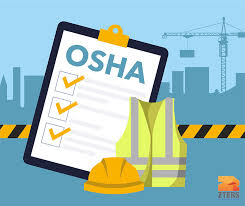Ensuring Workplace Safety: Navigating OSHA Regulatory Compliance

OSHA Regulatory Compliance: Ensuring Workplace Safety
Occupational Safety and Health Administration (OSHA) regulations play a crucial role in maintaining safe and healthy work environments across various industries. Compliance with OSHA standards is not only a legal requirement but also a moral obligation for employers to protect their employees from workplace hazards.
OSHA sets forth guidelines and regulations that cover a wide range of safety aspects, including but not limited to:
- Hazard communication
- Personal protective equipment
- Emergency action plans
- Machine guarding
- Respiratory protection
Ensuring compliance with OSHA regulations involves several key steps:
- Evaluation of workplace hazards: Identifying potential risks and assessing the current safety measures in place.
- Implementation of safety protocols: Developing and implementing safety procedures, training programs, and emergency response plans.
- Regular inspections and audits: Conducting routine inspections to identify any non-compliance issues and taking corrective actions promptly.
- Employee involvement: Engaging employees in safety initiatives, providing training on OSHA standards, and encouraging reporting of unsafe conditions.
Failure to comply with OSHA regulations can result in severe penalties, fines, lawsuits, and reputational damage for businesses. It is essential for employers to stay informed about the latest regulatory updates and ensure full adherence to avoid costly consequences.
In conclusion, prioritizing OSHA regulatory compliance is not just a legal requirement but a fundamental commitment to creating a safe and healthy work environment for all employees. By proactively addressing workplace safety issues and upholding OSHA standards, organizations can protect their workforce, enhance productivity, and build a positive reputation within their industry.
7 Essential Tips for Achieving OSHA Regulatory Compliance
- Ensure proper training for all employees on OSHA regulations.
- Regularly inspect and maintain equipment to meet safety standards.
- Implement clear communication of safety procedures and protocols.
- Provide necessary personal protective equipment (PPE) for employees.
- Keep accurate records of incidents, injuries, and safety training.
- Stay updated on any changes in OSHA regulations relevant to your industry.
- Encourage a culture of safety awareness and reporting in the workplace.
Ensure proper training for all employees on OSHA regulations.
To maintain OSHA regulatory compliance effectively, it is crucial to ensure that all employees receive proper training on OSHA regulations. By providing comprehensive training programs, employees can gain a clear understanding of safety protocols, hazard identification, and emergency procedures outlined by OSHA. Equipping staff with the knowledge and skills to recognize potential risks and adhere to safety guidelines not only enhances workplace safety but also demonstrates a commitment to prioritizing employee well-being. Regular training sessions can empower employees to contribute actively to a culture of safety and compliance within the organization.
Regularly inspect and maintain equipment to meet safety standards.
Regularly inspecting and maintaining equipment to meet safety standards is a crucial aspect of OSHA regulatory compliance. By conducting routine inspections and ensuring that equipment is in good working condition, employers can identify potential hazards early on and take corrective actions promptly. This proactive approach not only helps prevent workplace accidents but also demonstrates a commitment to prioritizing the safety and well-being of employees. Compliance with equipment maintenance guidelines not only enhances workplace safety but also contributes to a more efficient and productive work environment.
Implement clear communication of safety procedures and protocols.
Implementing clear communication of safety procedures and protocols is a crucial tip for ensuring OSHA regulatory compliance in the workplace. By clearly outlining safety guidelines, providing detailed instructions, and fostering open communication channels, employers can empower their employees to understand and follow safety protocols effectively. Clear communication helps to prevent misunderstandings, reduce the likelihood of accidents, and promote a culture of safety awareness among all staff members. It is essential for organizations to prioritize transparent communication of safety procedures as a foundational step towards creating a safe and compliant work environment in accordance with OSHA standards.
Provide necessary personal protective equipment (PPE) for employees.
To ensure OSHA regulatory compliance, it is crucial for employers to provide necessary personal protective equipment (PPE) for employees. PPE plays a vital role in safeguarding workers from potential workplace hazards and minimizing the risk of injuries or illnesses. By supplying appropriate PPE such as helmets, gloves, goggles, or respirators based on the nature of the job tasks, employers demonstrate their commitment to employee safety and compliance with OSHA standards. Proper training on the correct usage and maintenance of PPE should also be provided to ensure its effectiveness in protecting workers while on the job.
Keep accurate records of incidents, injuries, and safety training.
Keeping accurate records of incidents, injuries, and safety training is a crucial aspect of OSHA regulatory compliance. By maintaining detailed documentation of workplace incidents, injuries, and safety training sessions, employers not only demonstrate their commitment to employee safety but also ensure transparency and accountability within their organization. These records serve as valuable resources for identifying trends, assessing risks, and implementing preventive measures to enhance workplace safety standards. Additionally, accurate record-keeping helps businesses comply with OSHA reporting requirements and facilitates effective communication with regulatory authorities during inspections or audits.
Stay updated on any changes in OSHA regulations relevant to your industry.
It is crucial for businesses to stay updated on any changes in OSHA regulations relevant to their industry to ensure ongoing compliance with safety standards. By regularly monitoring updates and revisions to OSHA guidelines, organizations can proactively adjust their safety protocols, training programs, and workplace practices to align with the latest requirements. This proactive approach not only helps businesses avoid potential violations and penalties but also demonstrates a commitment to maintaining a safe and healthy work environment for employees. Keeping abreast of regulatory changes allows companies to adapt swiftly and effectively, fostering a culture of continuous improvement in workplace safety practices.
Encourage a culture of safety awareness and reporting in the workplace.
Encouraging a culture of safety awareness and reporting in the workplace is paramount to ensuring OSHA regulatory compliance. By fostering an environment where employees feel empowered to identify and report potential hazards or safety concerns, organizations can proactively address issues before they escalate. Emphasizing the importance of safety awareness not only enhances workplace safety but also promotes a sense of responsibility and accountability among employees. Regular training, open communication channels, and recognition for safety-conscious behavior can help instill a culture where safety is everyone’s priority, ultimately creating a safer and more compliant work environment.


